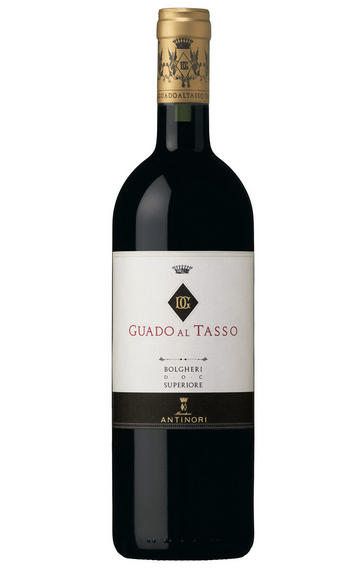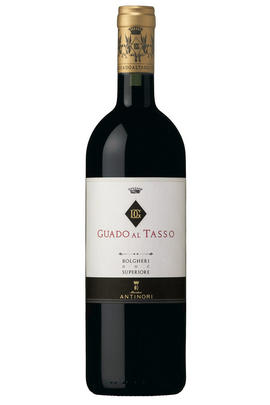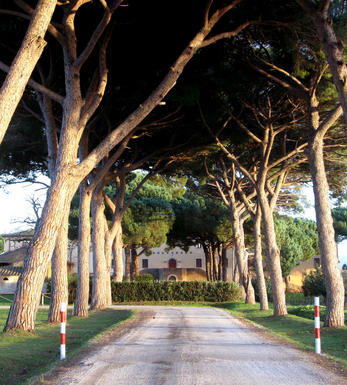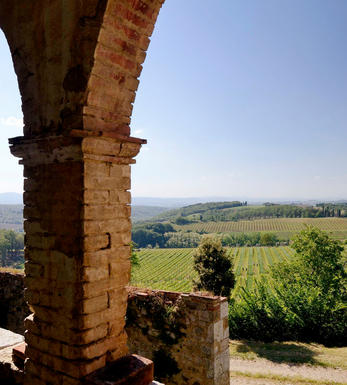
2018 Guado al Tasso, Bolgheri Superiore, Antinori, Tuscany, Italy

Critics reviews
Drink 2024 - 2033
Antonio Galloni, vinous.com (Dec 2020)
Renzo Cotarella, managing director of Marchesi Antinori tells me that the 2018 vintage showed very different results in the inland and hilly Chianti Classico appellation compared to the flat, sea-facing Bolgheri appellation. This season saw some rain right before harvest. That extra humidity rolled right off the Chianti Classico hills and disappeared without effect, but it stuck around longer in the thicker, flatter soils of Guado al Tasso. For this reason, one of the estate's top wines, the Cabernet Franc-based Matarocchio, was not produced in 2018 for fear that the fruit would not offer the concentration required of a wine of that important stature. The best of that fruit was used in this wine instead. For that reason, the 2018 Bolgheri Superiore Guado al Tasso sees a little more Cabernet Franc (clocking in at about 22% of the blend) and less Merlot, with the rest being Cabernet Sauvignon, of course, (at about 60%).
To be honest, the percentage of Cabernet Franc has been deliberately creeping up over the years to render a more focused and sharper bouquet. Aromas of dark fruit and freshly milled white pepper replace the more banal cherry-based flavours delivered by the Merlot, and the wine appears more lifted and precise as a result. The Cabernet Sauvignon delivers spice and liquorice, and these pretty aromas are likewise given more breathing room, thanks to the counterparts found in the Cabernet Franc. Linearity, sharpness, pencil shavings and dark currant or blackberry—this is the direction Guado al Tasso is taking, and this 2018 vintage opens the door to a new chapter for the wine. Some 115,000 bottles were made.
Drink 2024 - 2045
Monica Larner, Wine Advocate (May 2021)
James Suckling, jamessuckling.com (Apr 2021)
About this WINE

Antinori
Antinori is the most famous name in Italian wine and the influence of Piero Antinori in the last 25 years has been nothing short of revolutionary. Antinori's flagship wine, Tignanello, first appeared in 1971 and caused a sensation by its use of Cabernet Sauvignon in a Sangiovese blend and with its practice of ageing in small French barriques. Antinori was accused of vinous treachery and treason but soon barrique-aged blends of Sangiovese and Cabernet began appearing all across Tuscany.
Solaia is a Cabernet-dominated blend, which, like Tignanello, is from the Santa Cristina estate and is stunningly rich. Tenuta Belvedere is in Bolgheri on the Mediterranean coast .
The Guado al Tasso estate is also part of the small, prestigious Bolgheri DOC zone which has been famous for its Rosé wines since the Seventies: along with the white wines made here, they were awarded the DOC in 1984, which was extended to the reds in 1994. The area is now best-known and admired for its outstanding red wines, the so-called Super-Tuscans. The estate covers over 1,000 hectares, 300 of which are planted with vineyards, and the rest with wheat, sunflowers and olives
Tenuta Guado al Tasso was part of feudal lands of about 4,048 hectares along about 7km of coast and belonged to the Della Gherardesca family, whose roots in this region date back to over 1,200 years ago. In the Thirties the land was inherited by Carlotta della Gherardesca Antinori - mother of Piero Antinori - and her sister, who was married to Mario Incisa della Rocchetta (who took possession of the nearby Tenuta San Guido). There were seven castles on the estate, four of which are still standing, and 86 watchtowers, built 1000 years ago to protect the family from Saracen invaders from the African coast.
There are currently 300 hectares of vineyards at Tenuta Guado al Tasso, situated at an altitude of 45-60m a.s.l. on various types of soil. The varieties planted are Vermentino (a grape variety native to the coastal area of Liguria and northern Tuscany, which has also flourished for many years in Corsica and Sardinia), Sangiovese, Cabernet Sauvignon, Merlot and Syrah. There are also small quantities of other varieties including Cabernet Franc.
Many ideas and resources have been invested in the Guado al Tasso estate, for constant research into improved quality: as a result, a nursery for rooted cuttings was created here in 1994, mainly for the propagation of Vermentino, but also to produce the best possible selections of Sangiovese, Cabernet Sauvignon and Merlot for use in other Antinori estates.
The mitigating influence of the Mediterranean prevents drastic temperature variations and the vines flower and ripen early, thanks to the stable, fairly warm microclimate with its extraordinary light during the final phases of ripening. Thanks to the microclimate of the "Bolgheri amphitheatre", harvesting takes place early here, about two weeks before the Chianti harvest.
The Guado al Tasso estate makes Scalabrone (Bolgheri Rosato DOC) from Sangiovese, Merlot and Syrah, Vermentino di Bolgheri DOC, a monovarietal Vermentino (made for the first time in 1996) and since 1990, the Guado al Tasso Bolgheri DOC Superiore from Cabernet Sauvignon and Merlot grapes.

Bolgheri
Bolgheri is a new DOC in the coastal Maremma region which first rose to prominence during the 1970s with the emergence of the so-called Super Tuscan wines like Ornellaia and Sassicaia. These new ventures had rocked the DOC establishment by using high proportions of Cabernet Sauvignon, opting out of the DOC system and relabeling their wines as simply Vino da Tavola (table wine).
Having won universal acclaim and exchanging hands for unprecedented prices (higher even than Tuscany's finest examples), the authorities relented and awarded Bolgheri its own DOC. The actions of the Super Tuscans inspired a generation in Italy, even if some of the wines here have lost a little of their lustre since.

Cabernet Sauvignon Blend
Cabernet Sauvignon lends itself particularly well in blends with Merlot. This is actually the archetypal Bordeaux blend, though in different proportions in the sub-regions and sometimes topped up with Cabernet Franc, Malbec, and Petit Verdot.
In the Médoc and Graves the percentage of Cabernet Sauvignon in the blend can range from 95% (Mouton-Rothschild) to as low as 40%. It is particularly suited to the dry, warm, free- draining, gravel-rich soils and is responsible for the redolent cassis characteristics as well as the depth of colour, tannic structure and pronounced acidity of Médoc wines. However 100% Cabernet Sauvignon wines can be slightly hollow-tasting in the middle palate and Merlot with its generous, fleshy fruit flavours acts as a perfect foil by filling in this cavity.
In St-Emilion and Pomerol, the blends are Merlot dominated as Cabernet Sauvignon can struggle to ripen there - when it is included, it adds structure and body to the wine. Sassicaia is the most famous Bordeaux blend in Italy and has spawned many imitations, whereby the blend is now firmly established in the New World and particularly in California and Australia.


Buying options
Add to wishlist
Description
The 2018 Guado al Tasso has more Cabernet Franc than usual; vintage conditions meant the estate did not produce their iconic Matarocchio, so the best of that fruit was used here instead. It still displays those wonderful black fruit, plum and cherry notes, but there’s a precision, focus and balance to this Super Tuscan. The nose shows fruits of the forest, spice, dark chocolate and pepper. The wine is finely balanced, elegant and precise with svelte black fruit, pencil shaving and filigree tannins. This is finely honed, much like a top-end St Emilion. Drink 2026-2035.
Stuart Rae, Commercial Manager, Berry Bros. & Rudd (July 2021)
wine at a glance
Delivery and quality guarantee